Investigation the Influence of Different Salts on the Degradation of Organic Dyes Using Non-Thermal Plasma
Abstract
:1. Introduction
2. Materials and Methods
2.1. Dye Solutions
2.2. Non-Thermal Plasma Reactor
3. Results and Discussion
3.1. Impact of the Presence of Diverse Salts in the Dye Solutions
3.2. H2O2 Concentration Measurement
3.3. Ozone Concentration in Treated Water
3.4. Energy Yield for Decolorization of Acid Blue 25 Dye
3.5. Electrical Energy Per Order (EE/O)
4. Conclusions
Acknowledgments
Author Contributions
Conflicts of Interest
References
- Njatawidjaja, E.; Sugiarto, A.T.; Ohshima, T.; Sato, M. Decoloration of electrostatically atomized organic dye by the pulsed streamer corona discharge. J. Electrostat. 2005, 63, 353–359. [Google Scholar] [CrossRef]
- Yang, Y.; Cho, Y.I.; Fridman, A. Plasma Discharge in Liquid Water Treatment and Applications; CRC Press: Boca Raton, FL, USA, 2012. [Google Scholar]
- Mok, Y.S.; Jo, J.O.; Whitehead, J.C. Degradation of an azo dye Orange II using a gas phase dielectric barrier discharge reactor submerged in water. Chem. Eng. J. 2008, 142, 56–64. [Google Scholar] [CrossRef]
- Dojcinovic, B.P.; Roglic, G.M.; Obradovic, B.M.; Kuraicac, M.M.; Kostićd, M.M.; Nešićb, J.; Manojlovićb, D.D. Decolorization of reactive textile dyes using water falling film dielectric barrier discharge. J. Hazard. Mater. 2011, 192, 763–771. [Google Scholar] [CrossRef] [PubMed]
- El-Tayeb, A.; El-Shazly, A.H.; Elkady, M.F.; Abdel-Rahman, A. Decolorization of acid blue 25 dye by non-thermal plasma advanced oxidation process for industrial wastewater treatment. In Proceedings of the 15th IEEE International Conference on Environment and Electrical Engineering (EEEIC 2015), Rome, Italy, 10–13 June 2015.
- PUBCHEM Open Chemistry Database. Available online: https://pubchem.ncbi.nlm.nih.gov/compound/Acid_Blue_25#section=InChI-Key (accessed on 28 July 2016).
- El-Tayeb, A.; El-Shazly, A.H.; Elkady, M.F.; Abdel-Rahman, A. Simulation and Experimental Study for Degradation of Organic Dyes Using Dual pin-to-plate Corona Discharge Plasma reactors for Industrial Wastewater Treatment. Contrib. Plasma Phys. 2016, 56, 855–869. [Google Scholar] [CrossRef]
- EL-Tayeb, A.; El Dein Adel, Z. Performance of Ceramic Insulator String for 132 kV under Different Polluted Conditions. J. Energy Power Sources 2014, 1, 152–160. [Google Scholar]
- El-Sayed Gouda, O.; El Dein Adel, Z.; EL-Tayeb, A. Prediction of flashover voltage and dry band location for polluted ceramic insulators using dynamic open-model. J. Energy Power Sources 2014, 1, 304–313. [Google Scholar]
- El-Tayeb, A.; El-Shazly, A.H.; Elkady, M.F.; Abdel-Rahman, A. Investigation of the Decolorization Efficiency of Two Pin-to-Plate Corona Discharge Plasma System for Industrial Wastewater Treatment. Plasma Phys. Rep. 2016, 42, 887–899. [Google Scholar] [CrossRef]
- Cheng, H.H.; Chen, S.S.; Wu, Y.C.; Ho, D.L. Non-Thermal Plasma Technology for Degradation of Organic Compounds in Wastewater Control: A Critical Review. Environ. Eng. Manag. J. 2007, 17, 427–433. [Google Scholar]
- El-Tayeb, A.; El-Shazly, A.H.; Elkady, M.F.; Abdel-Rahman, A. Non-thermal plasma as a new advanced technique for intensifying the industrial wastewater treatment. Desalination Water Treat. 2016, in press. [Google Scholar]
- Wanga, H.; Lib, J.; Quana, X. Decoloration of azo dye by a multi-needle-to-plate high-voltage pulsed corona discharge system in water. J. Electrostat. 2006, 64, 416–421. [Google Scholar] [CrossRef]
- El-Tayeb, A.; El-Shazly, A.H.; Elkady, M.F.; Abdel-Rahman, A. Simulation and experimental study for the effect of corona discharge plasma on the rate of wastewater treatment. Desalination Water Treat. 2016, in press. [Google Scholar]
- Zhang, Y.; Zhou, M.; Lei, L. Degradation of 4-chlorophenol in different gas liquid electrical discharge reactors. Chem. Eng. J. 2007, 132, 325–333. [Google Scholar] [CrossRef]
- El-Tayeb, A.; El-Shazly, A.H.; Elkady, M.F. Impacts of different salts on the degradation of acid blue 25 dye using non-thermal plasma. In Proceedings of the 16th IEEE International Conference on Environment and Electrical Engineering (EEEIC 2016), Florence, Italy, 7–10 June 2016.
- Dojčinovića, B.P.; Roglićb, G.M.; Obradovićc, B.M.; Kuraicac, M.M.; Kostićd, M.M.; Nešićb, J.; Manojlović, D.D. Decolorization of reactive textile dyes using water falling film dielectric barrier discharge. J. Hazard. Mater. 2011, 192, 763–771. [Google Scholar] [CrossRef] [PubMed]
- Overzet, L.J.; Leong-Rousey, F.Y. Time-resolved power and impedance measurements of pulsed radiofrequency discharges. Plasma Sources Sci. Technol. 1995, 4, 432443. [Google Scholar] [CrossRef]
- Aleksandrov, N.L.; Kindysheva, S.V.; Kosarev, I.N. Plasma decay in air and N2: O2: CO2 mixtures at elevated gas temperatures. In Proceedings of the 47th AIAA Aerospace Sciences Meeting Including The New Horizons Forum and Aerospace Exposition, Orlando, FL, USA, 5–8 January 2009.
- Šunka, P. Pulse electrical discharges in water and their applications. Phys. Plasmas 2001, 8, 25–87. [Google Scholar] [CrossRef]
- Chang, J.; Lawless, P.; Yamamoto, T. Corona discharge processes. IEEE Trans. Plasma Sci. 1991, 19, 1152–1166. [Google Scholar] [CrossRef]
- Ono, R.; Oda, T. Ozone production process in pulsed positive dielectric barrier discharge. J. Phys. D Appl. Phys. 2007, 40, 176. [Google Scholar] [CrossRef]
- Hayashi, Y.; Machmudah, S.; Takada, N.; Kanda, H.; Sasaki, K.; Goto, M. Decomposition of methyl orange using pulsed discharge plasm a at atmospheric pressure: Effect of different electrodes. Jpn. J. Appl. Phys. 2014, 53, 1. [Google Scholar] [CrossRef]
- Lukes, P.; Locke, B.R. Degradation of Substituted Phenols in a Hybrid Gas-Liquid Electrical Discharge Reactor. Ind. Eng. Chem. Res. 2005, 44, 2921–2930. [Google Scholar] [CrossRef]
- Krugly, E.; Martuzevicius, D.; Tichonovas, M.; Jankunaite, D.; Rumskaite, I.; Sedlina, J.; Racys, V.; Baltrusaitis, J. Decomposition of 2-naphthol in water using a non-thermal plasma reactor. Chem. Eng. J. 2015, 260, 188–198. [Google Scholar] [CrossRef]
- Khan, H.; Ahmad, N.; Yasar, A.; Shahid, R. Advanced Oxidative Decolorization of Red Cl-5B: Effects of Dye Concentration, Process Optimization and Reaction Kinetics. Pol. J. Environ. Stud. 2010, 19, 83–92. [Google Scholar]
- Marandi, R.; Olya, M.E.; Khosravi, M.; Khalilnezhad, R. Decolourisation of the dyes in aques solution using a new combinated system (UV/H2O2/biosorbent). J. Appl. Environ. Biol. Sci. 2013, 3, 71–80. [Google Scholar]
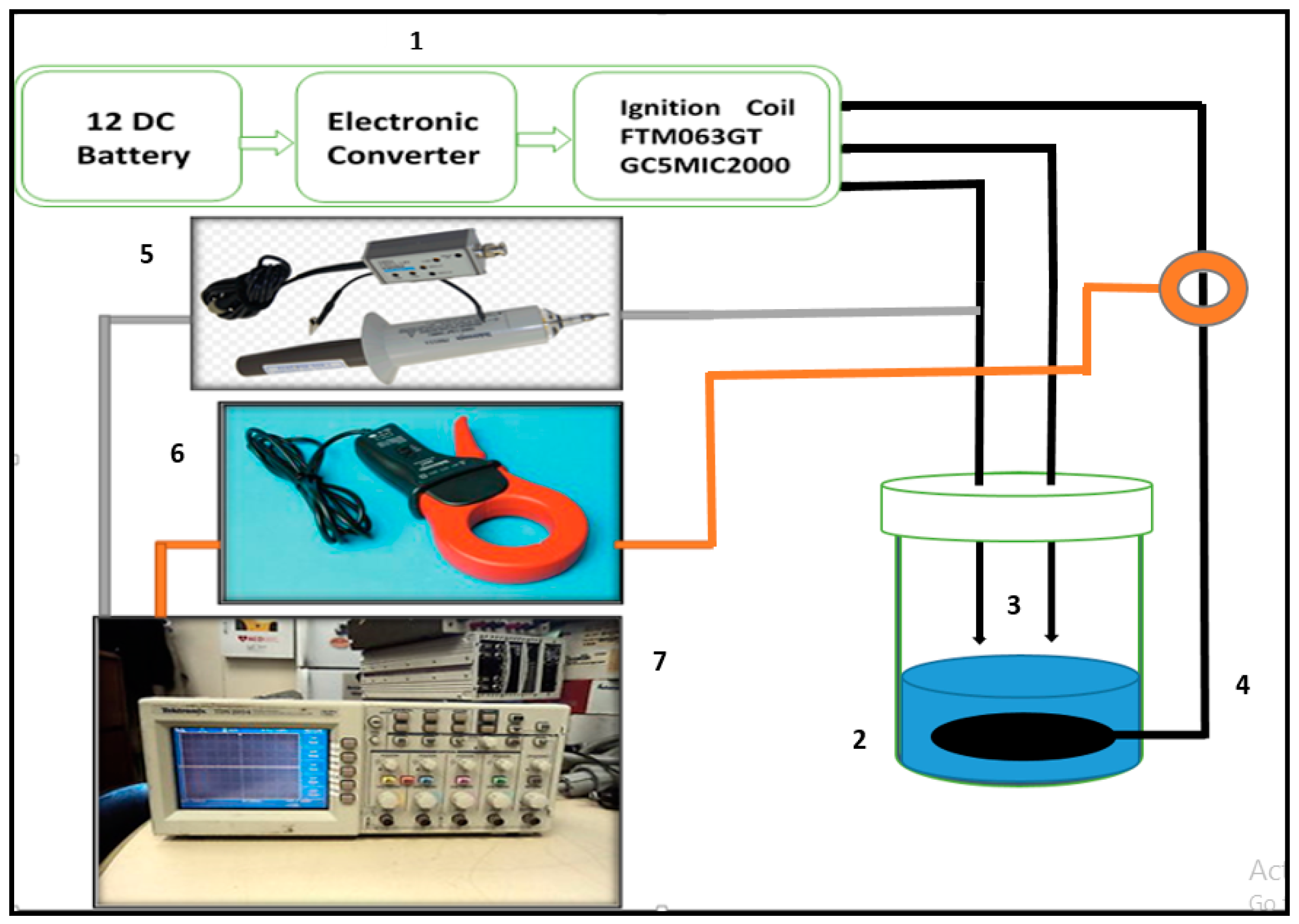
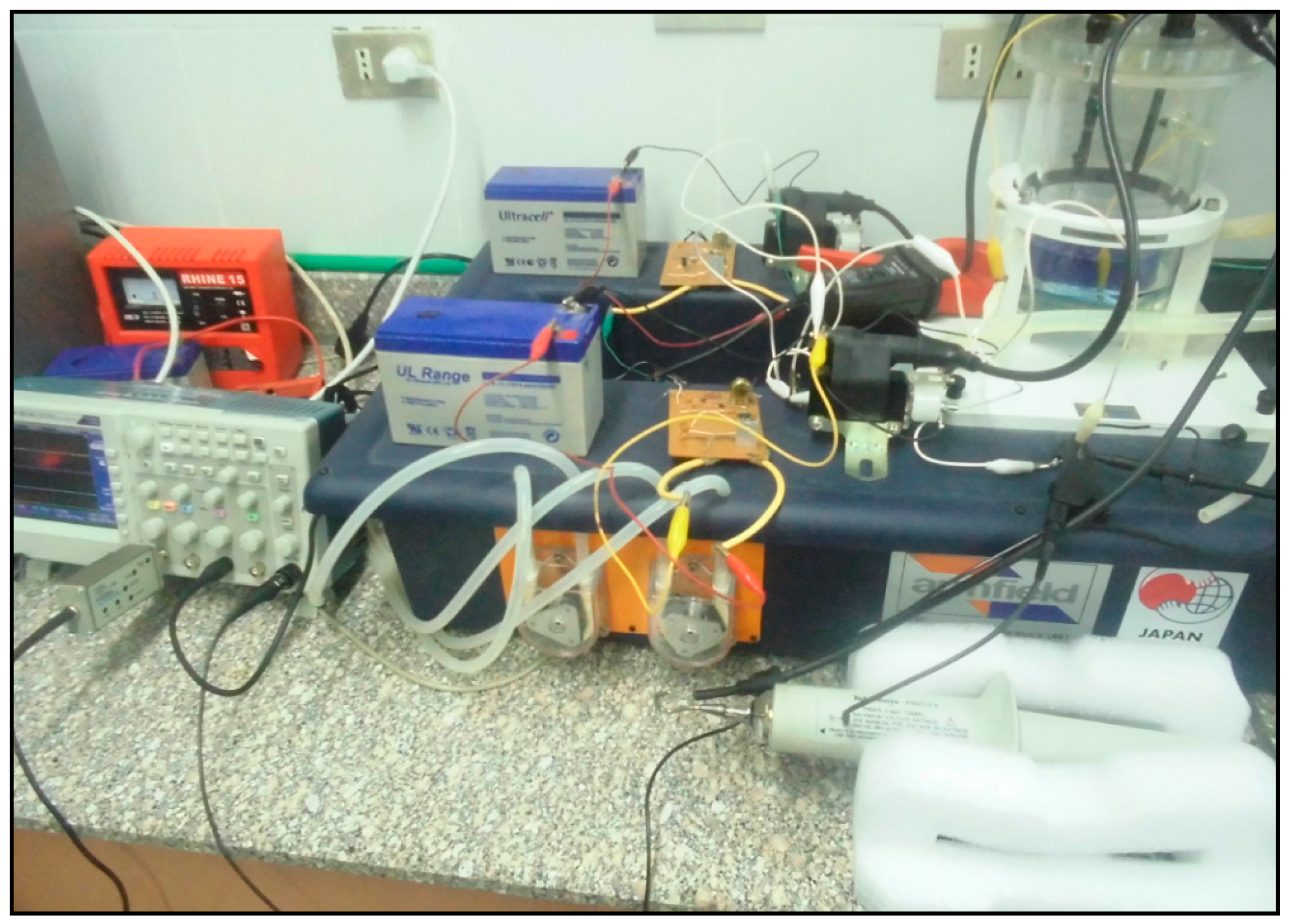

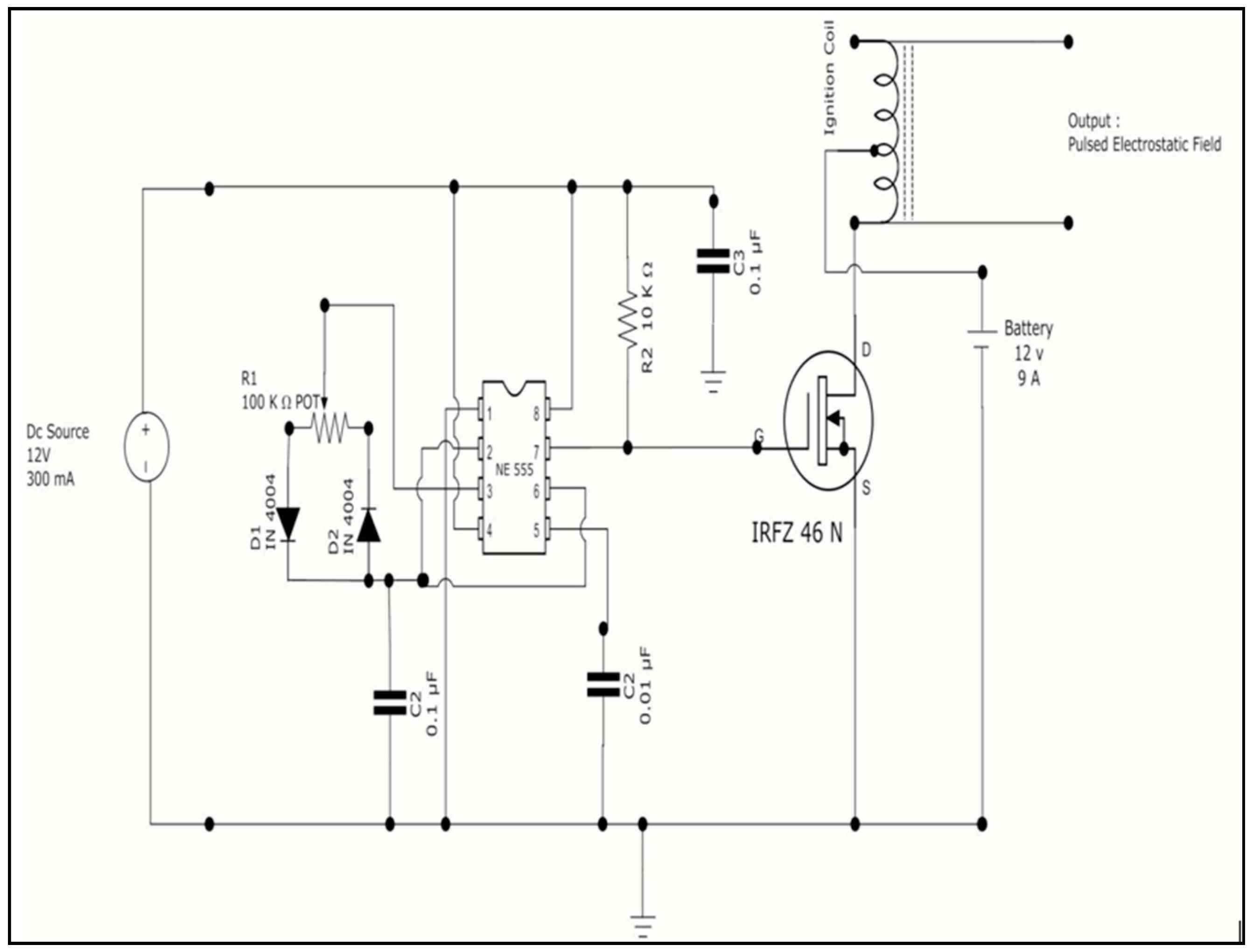
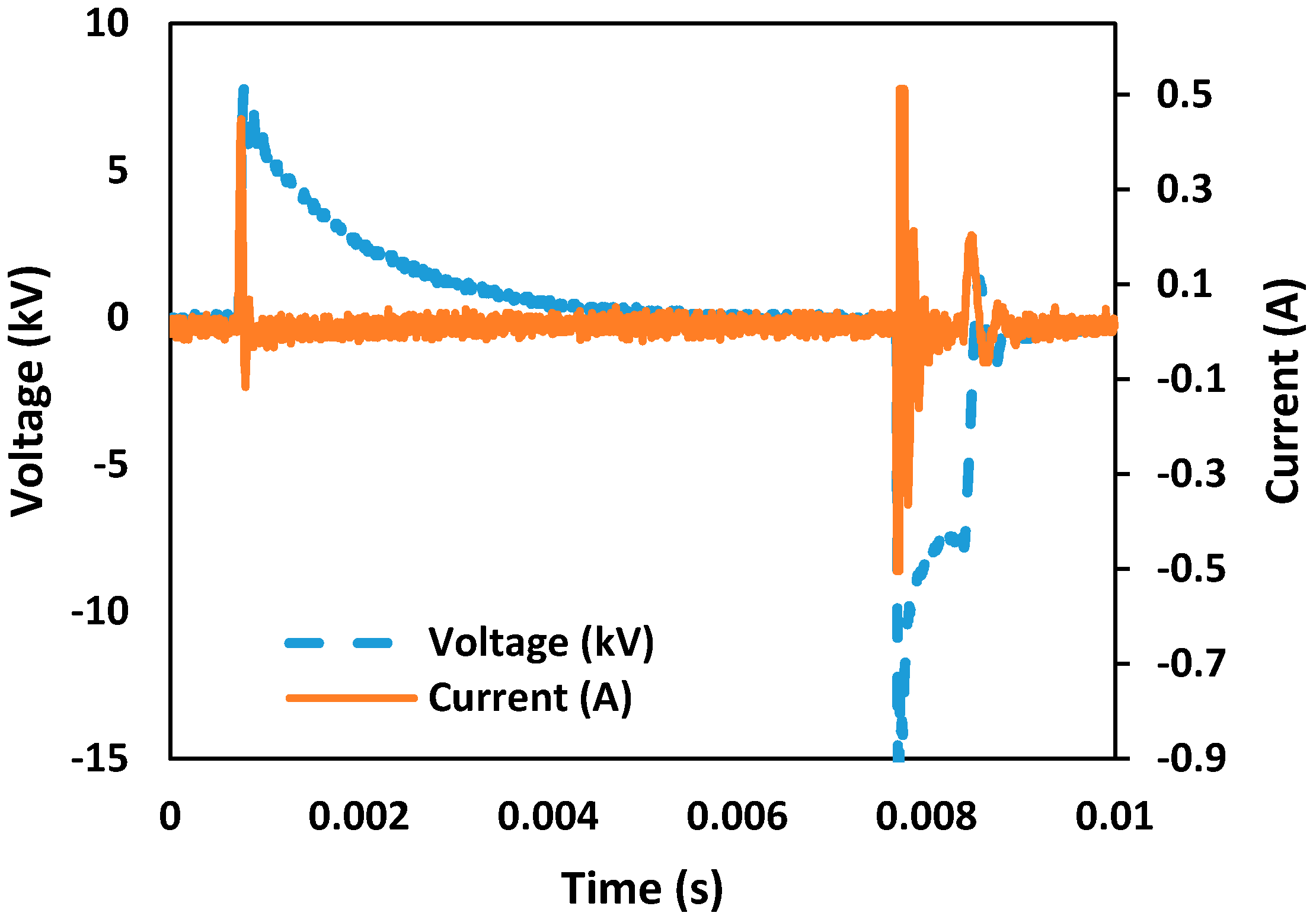
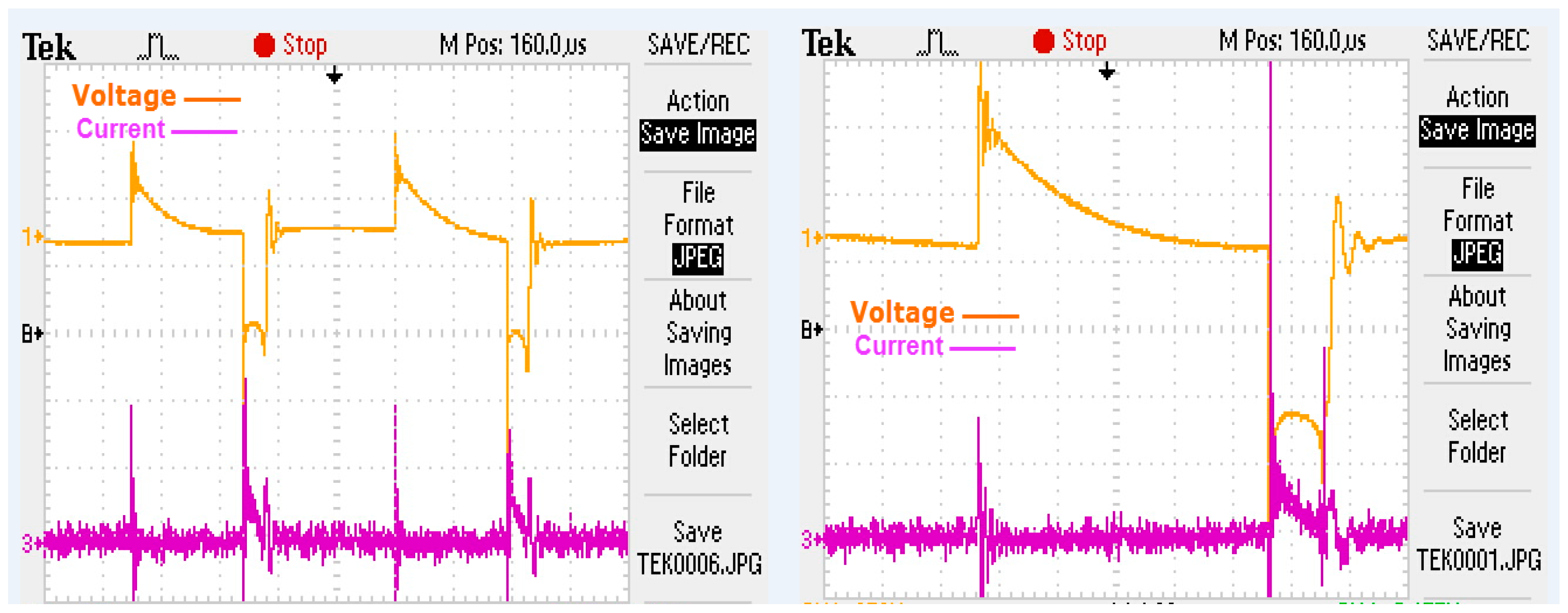
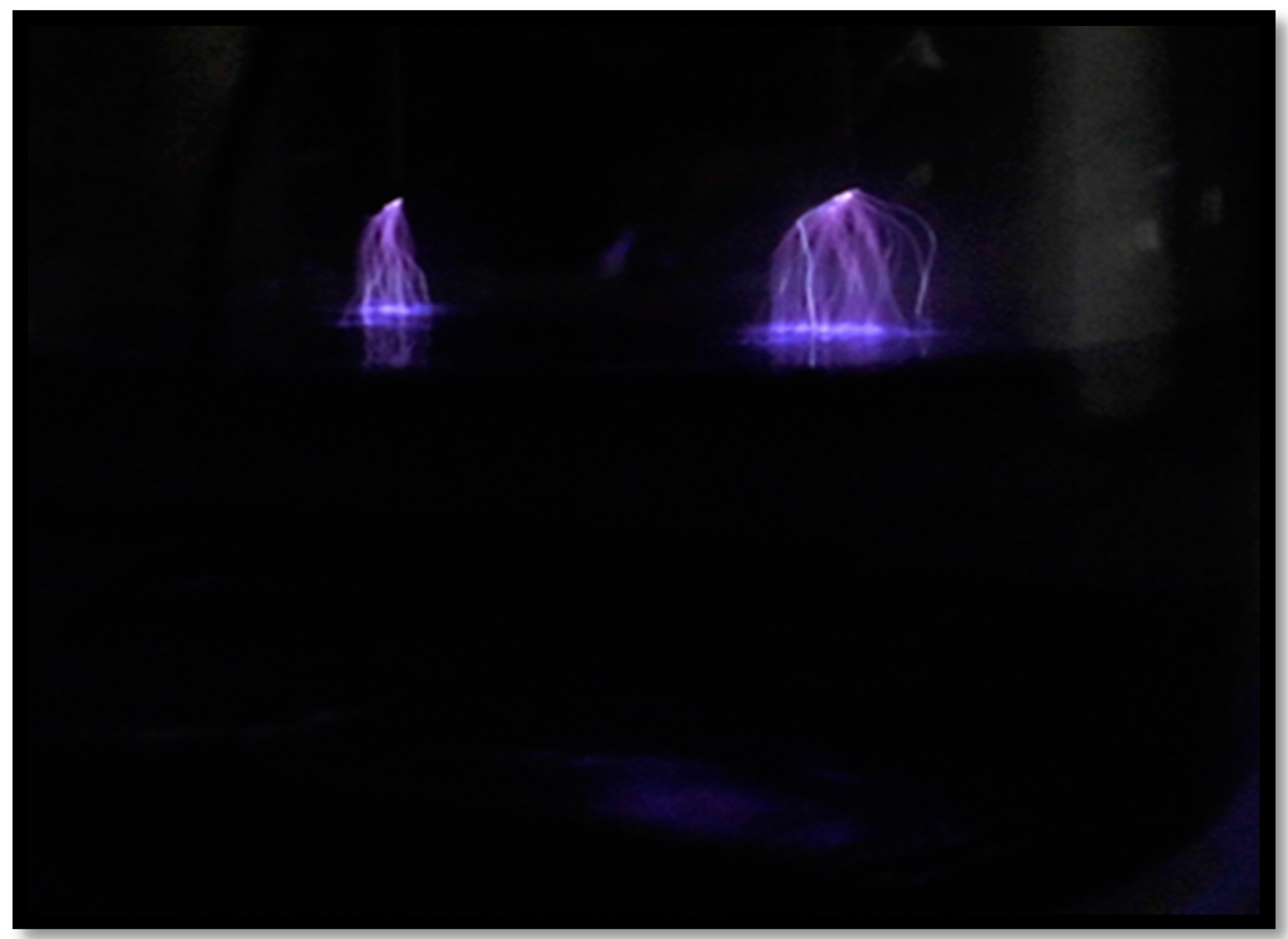

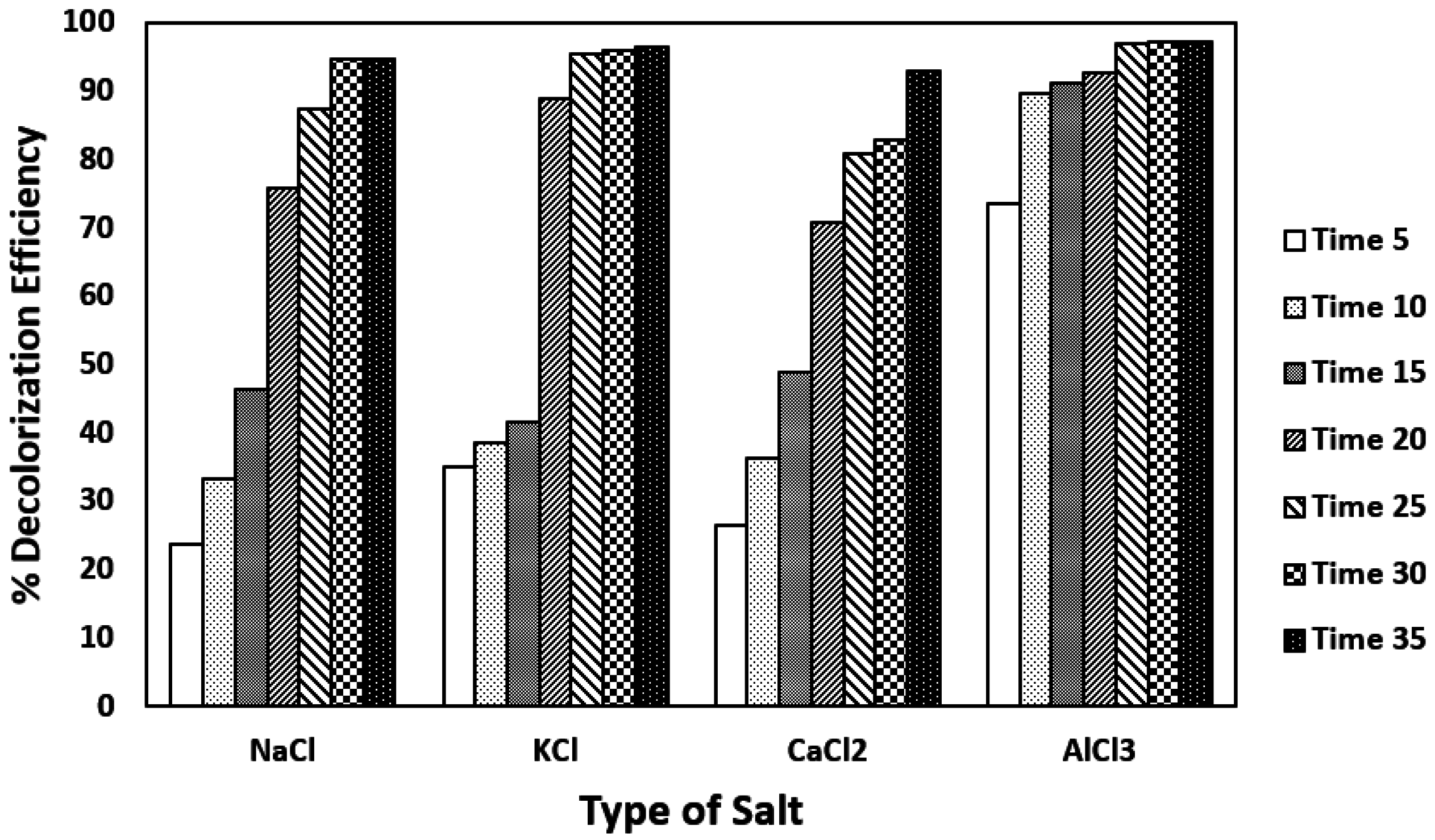

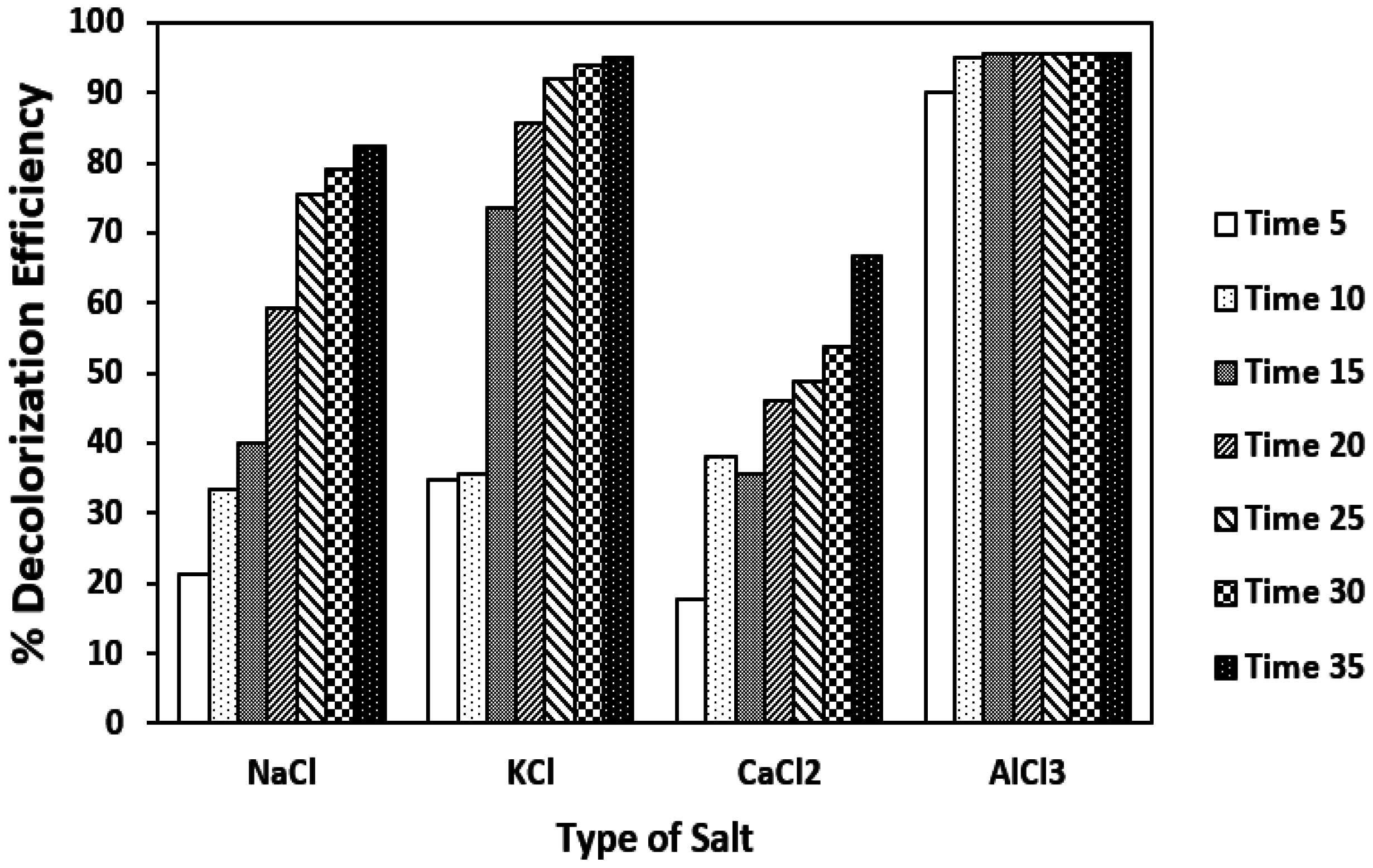
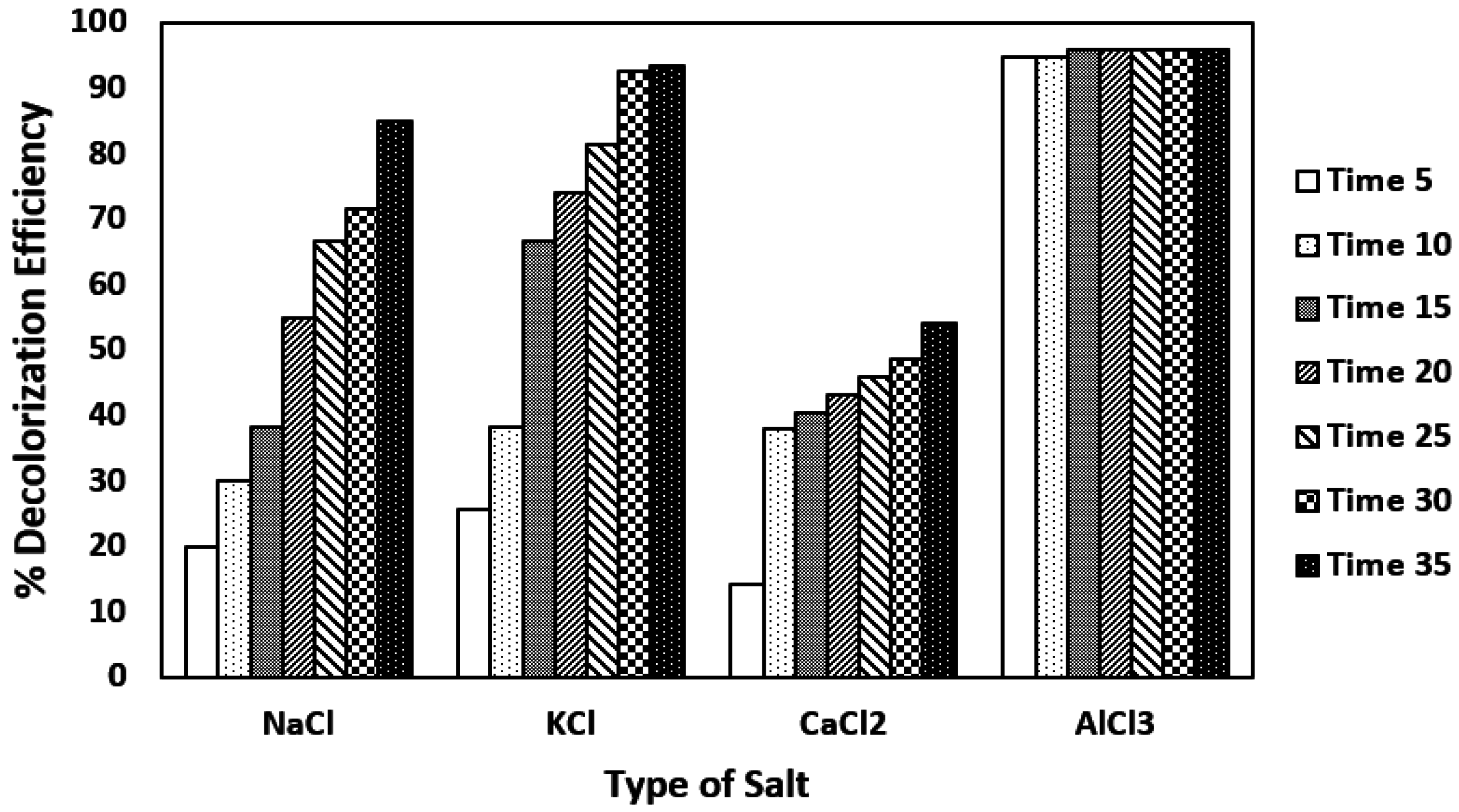
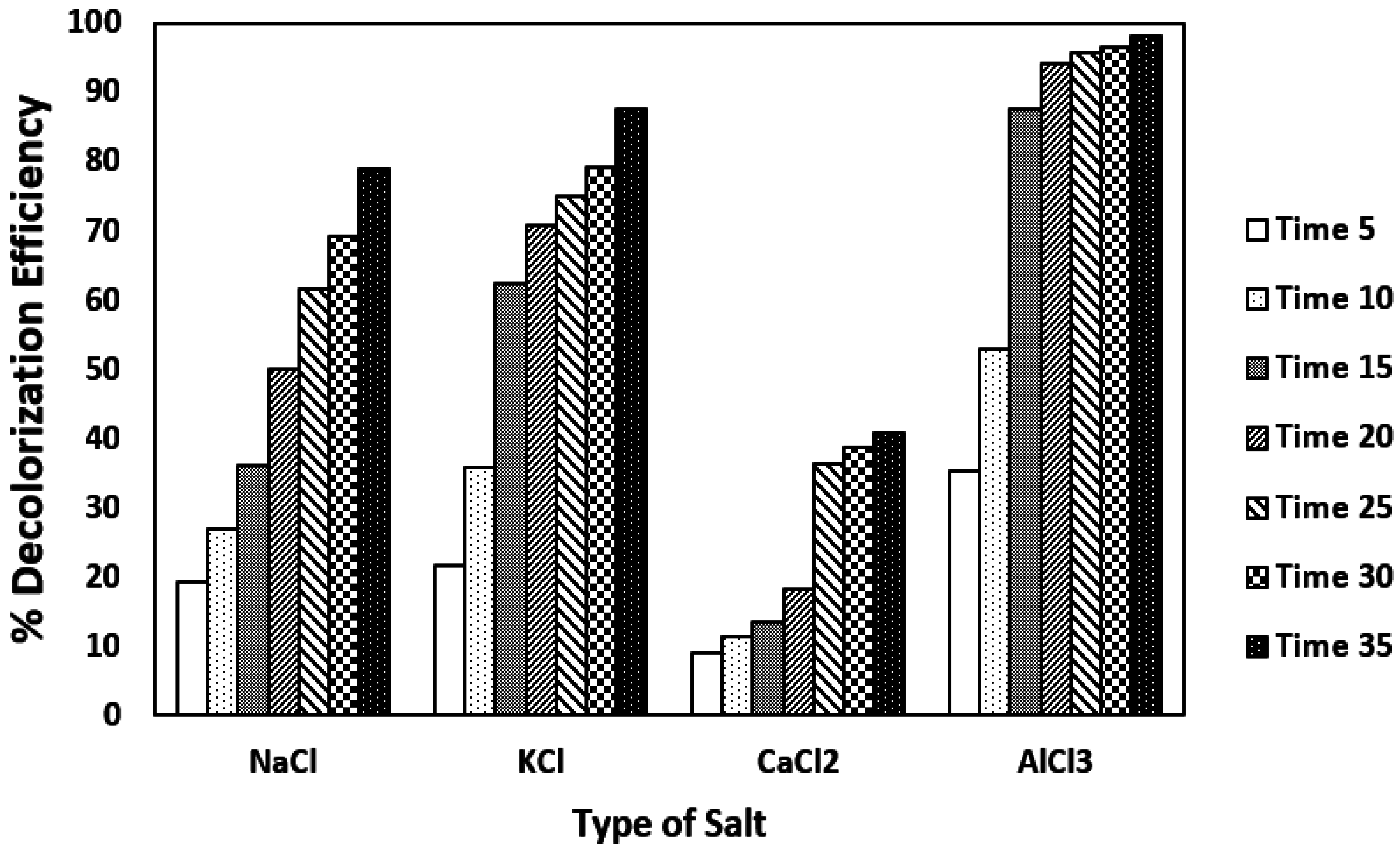
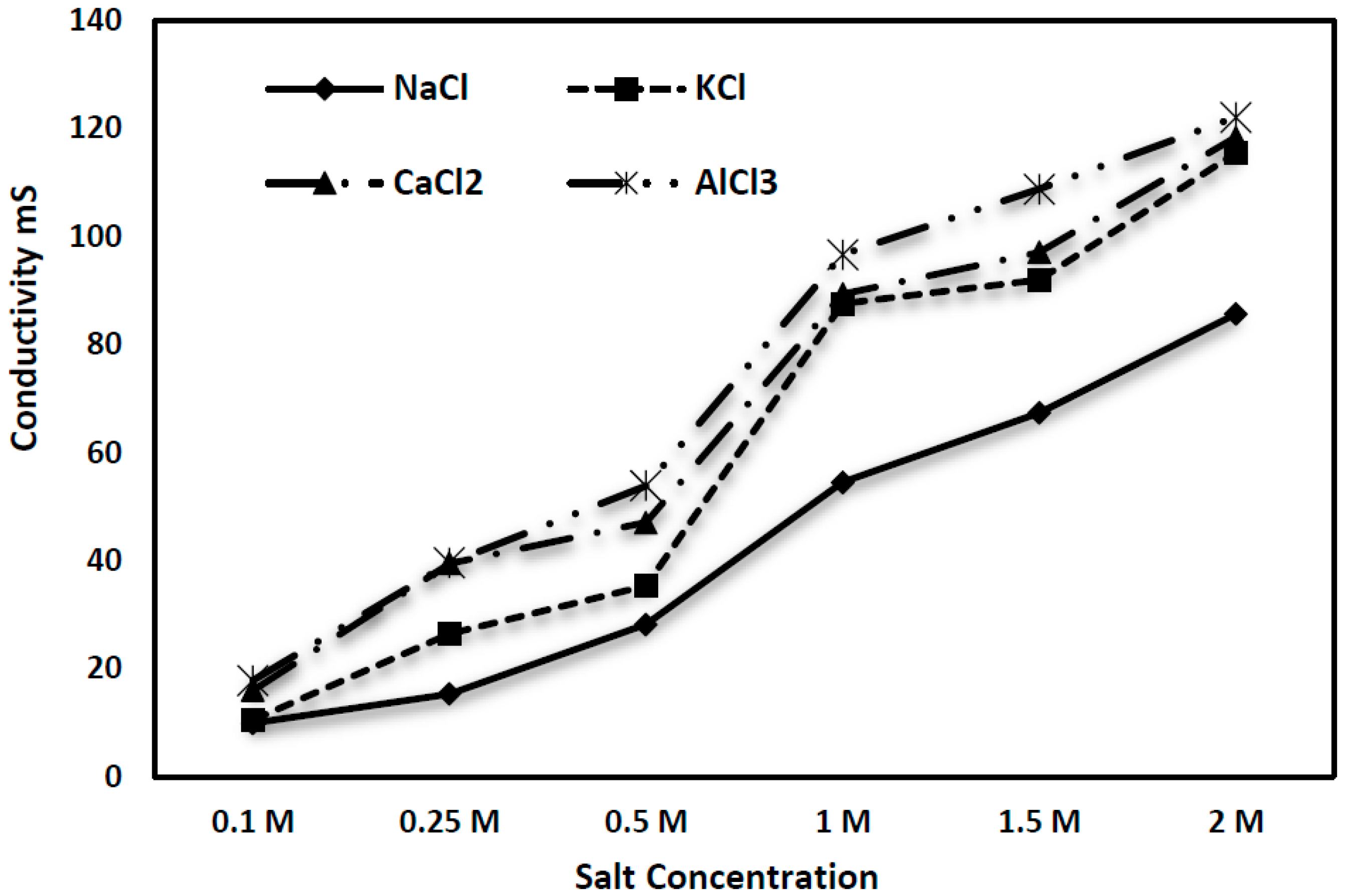
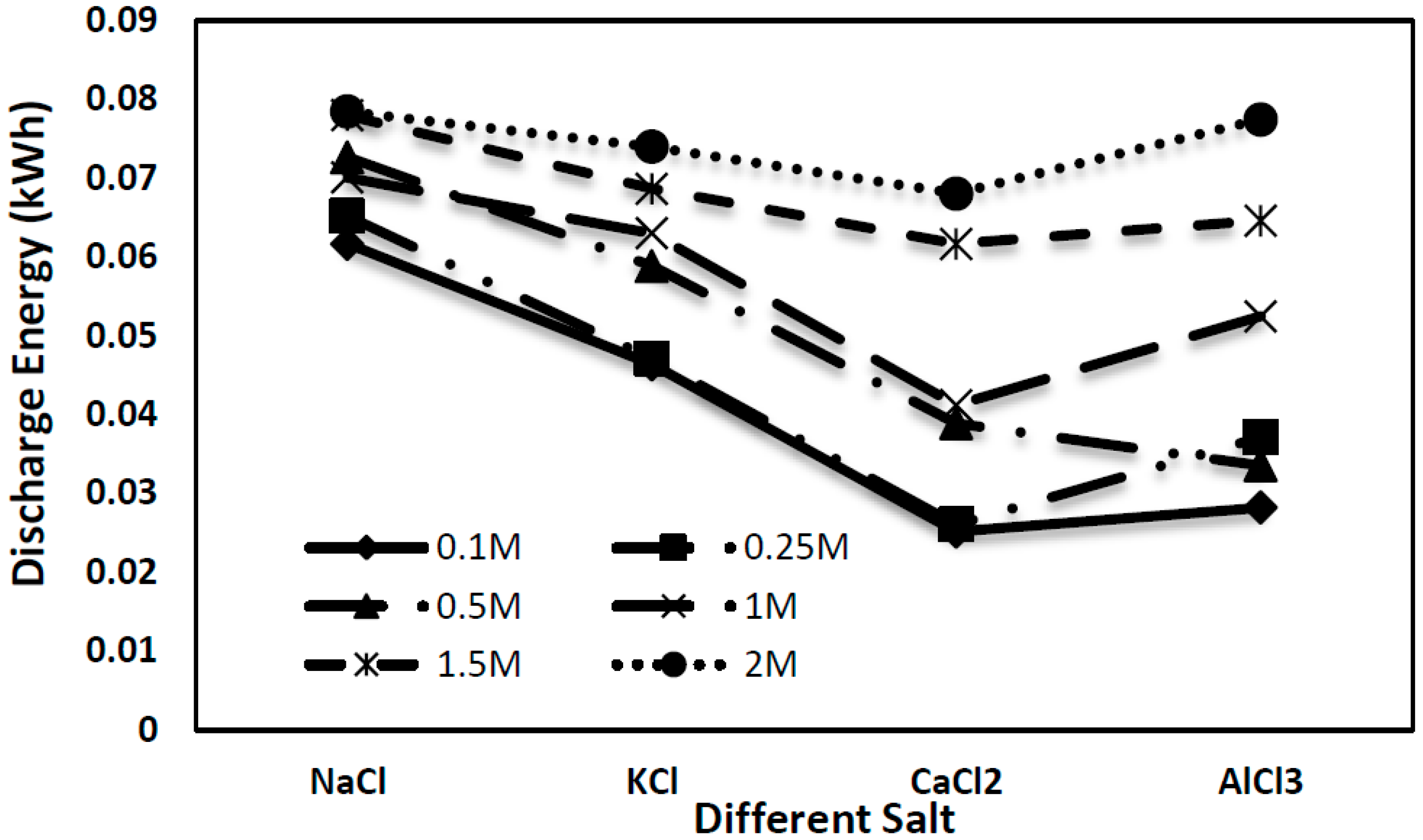

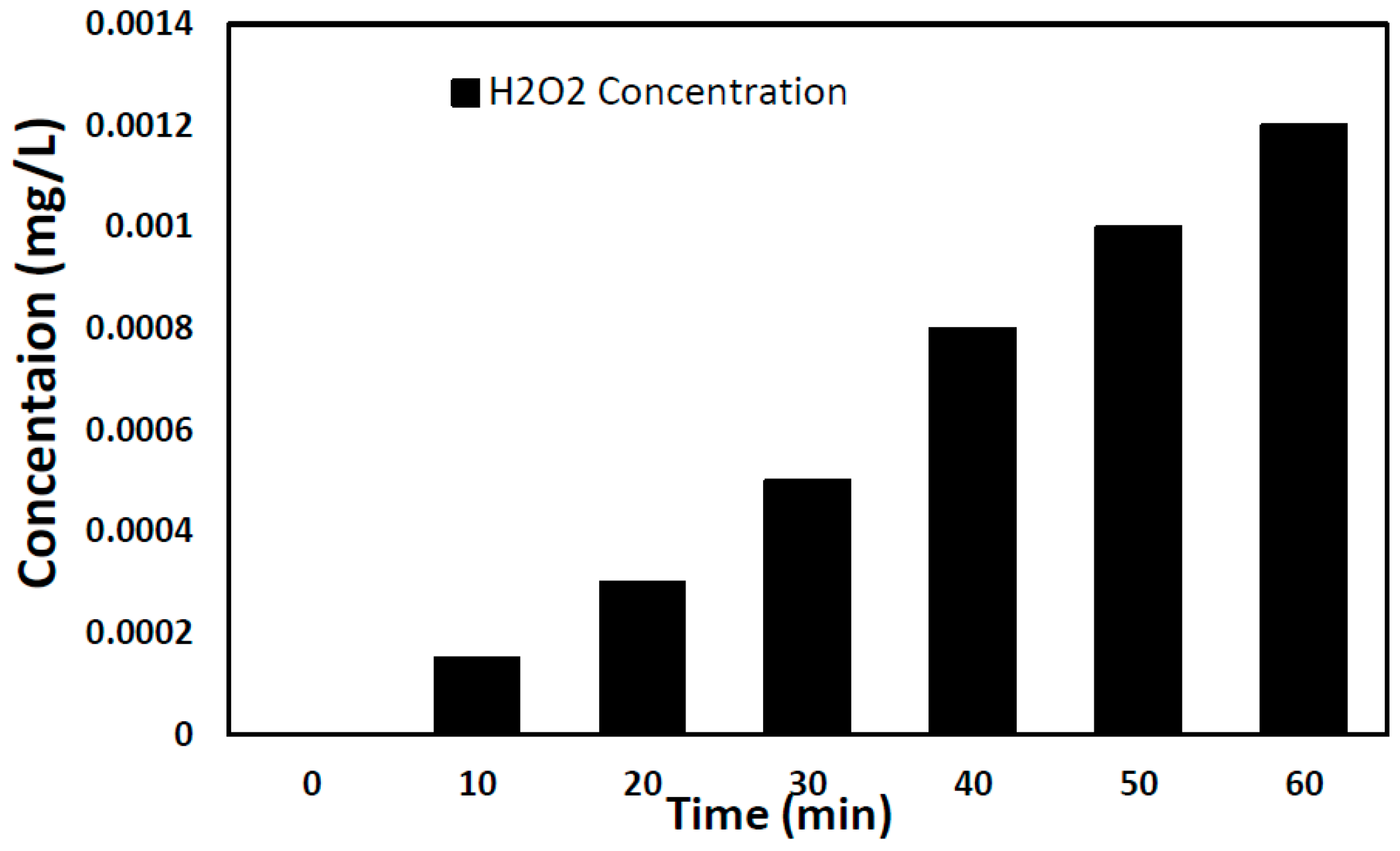
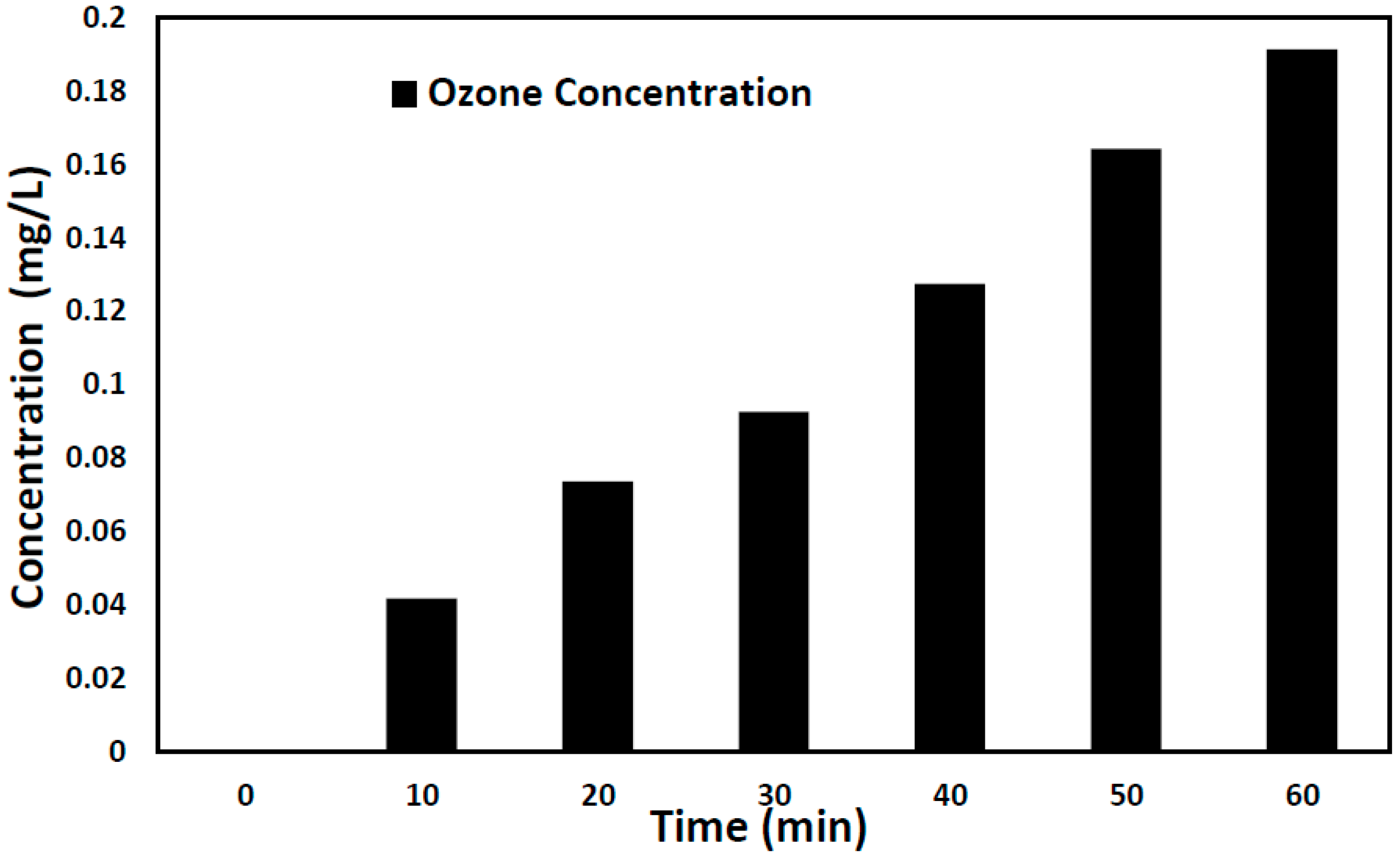
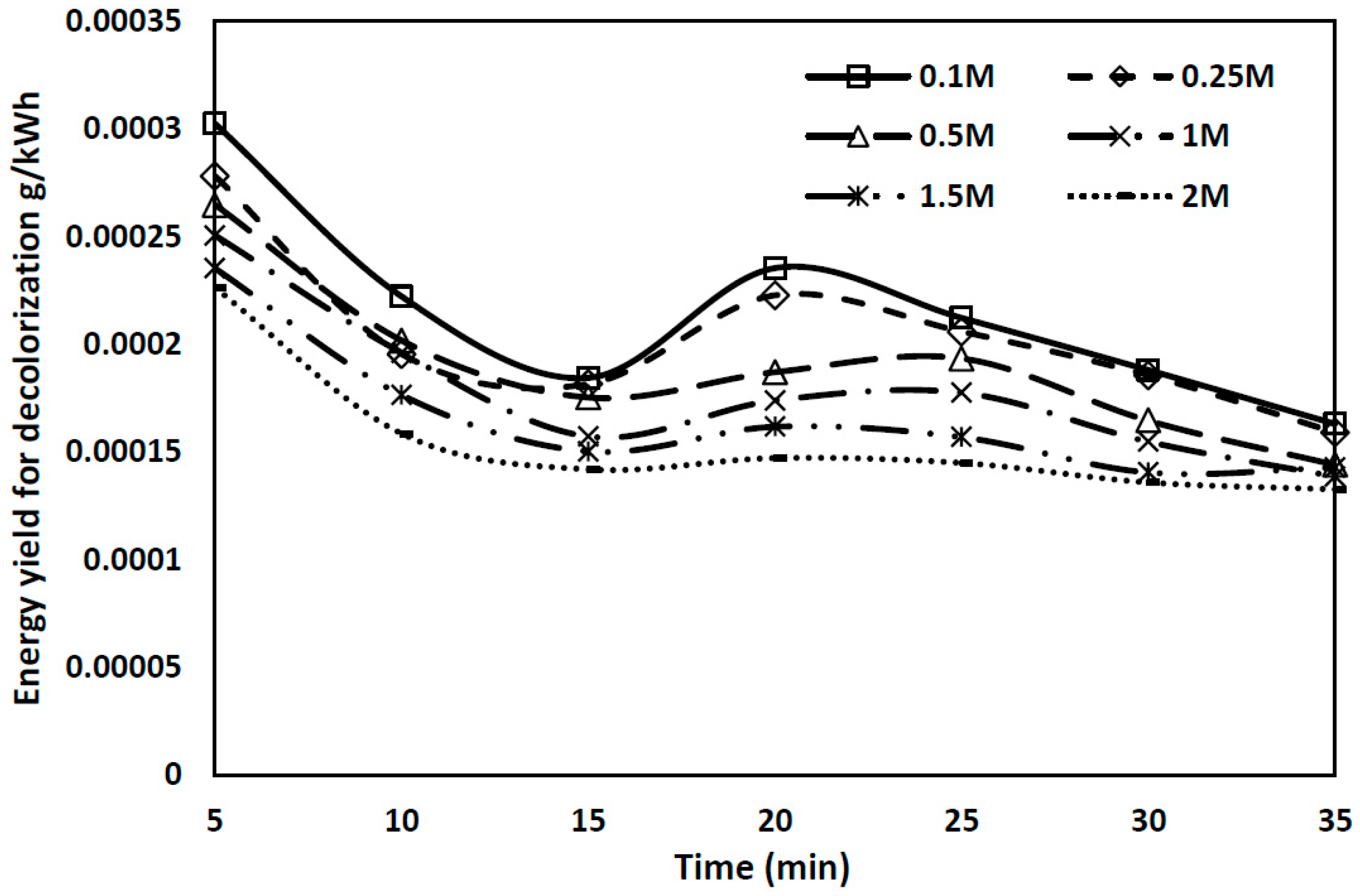
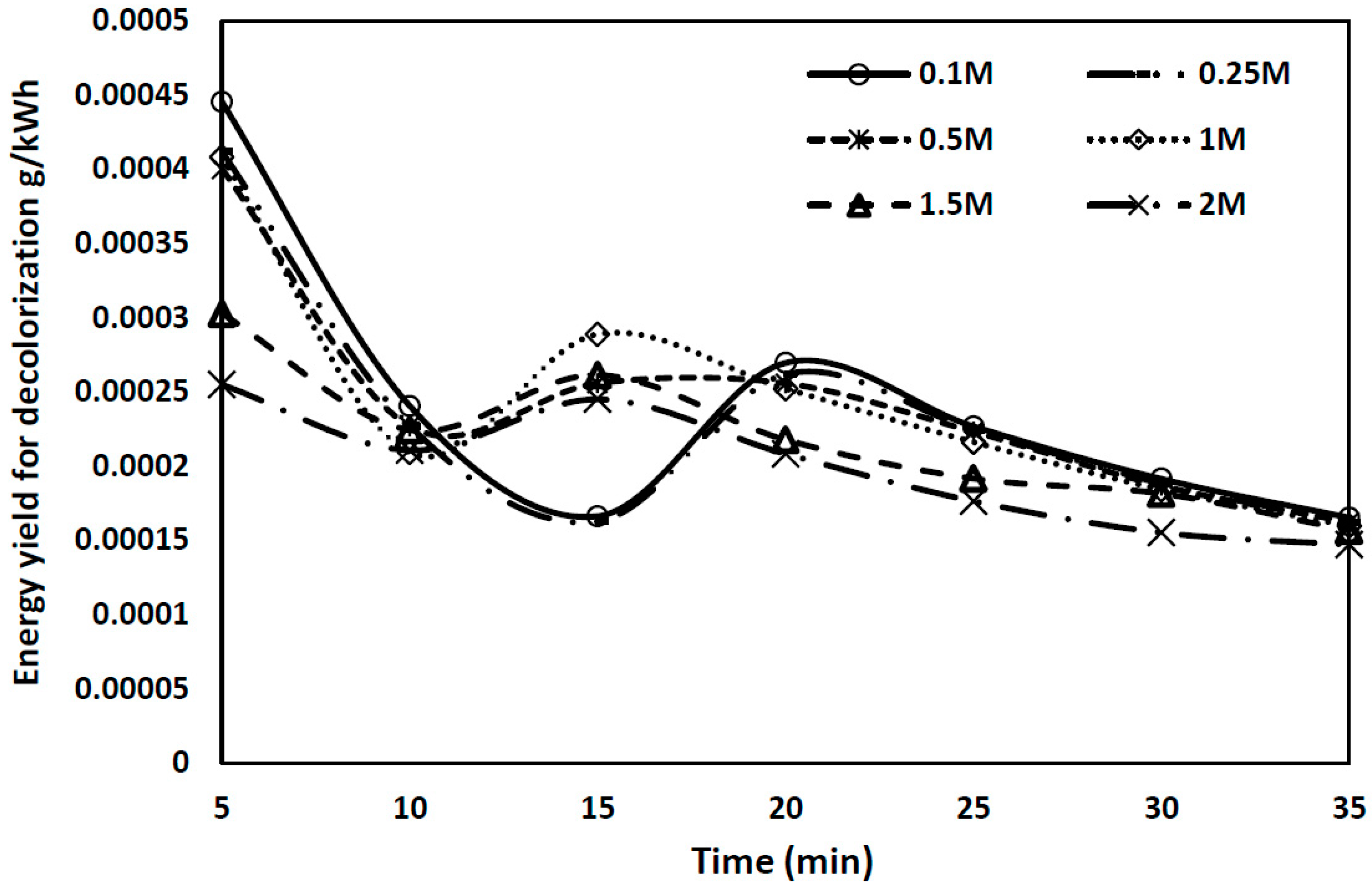


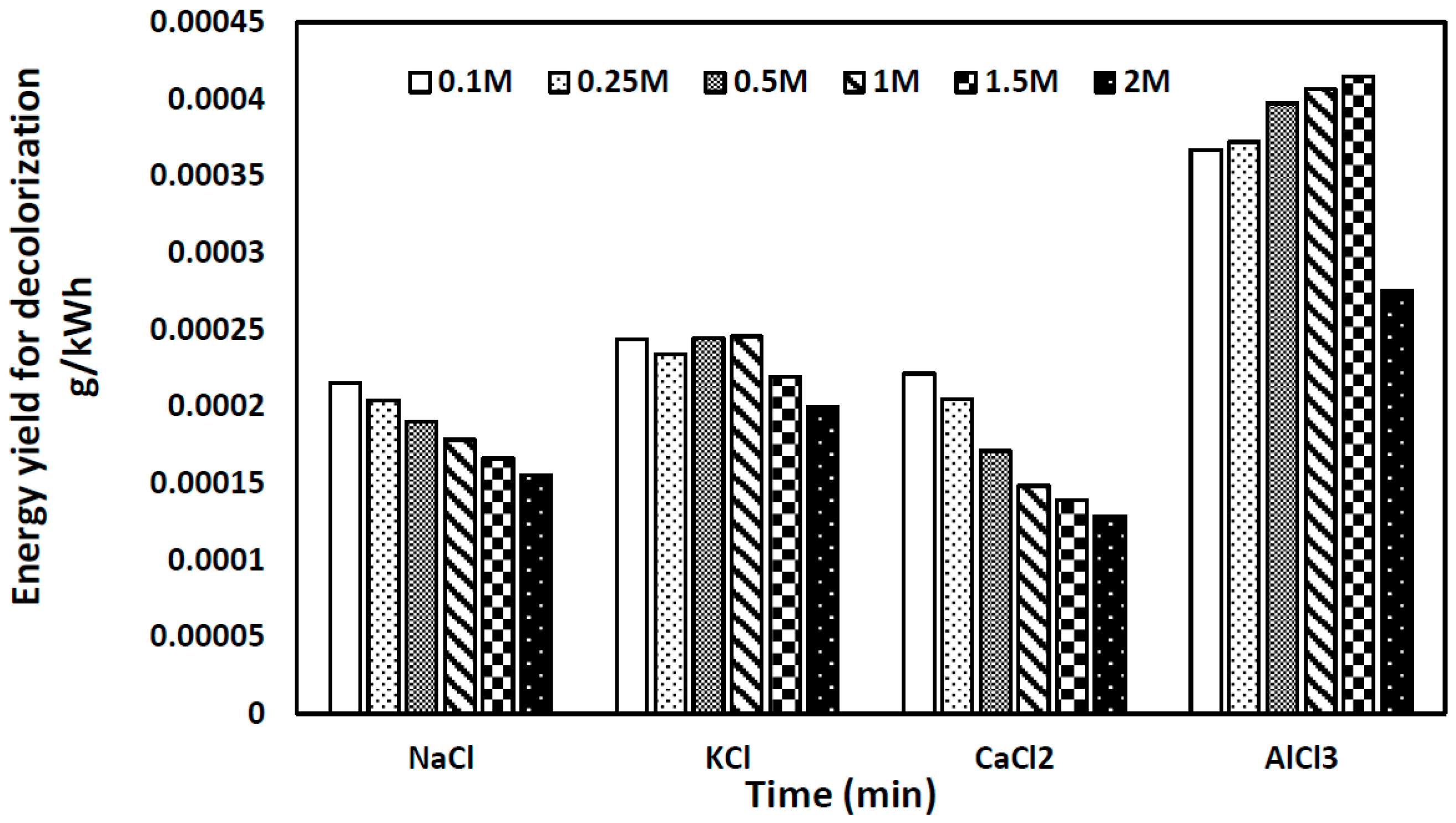

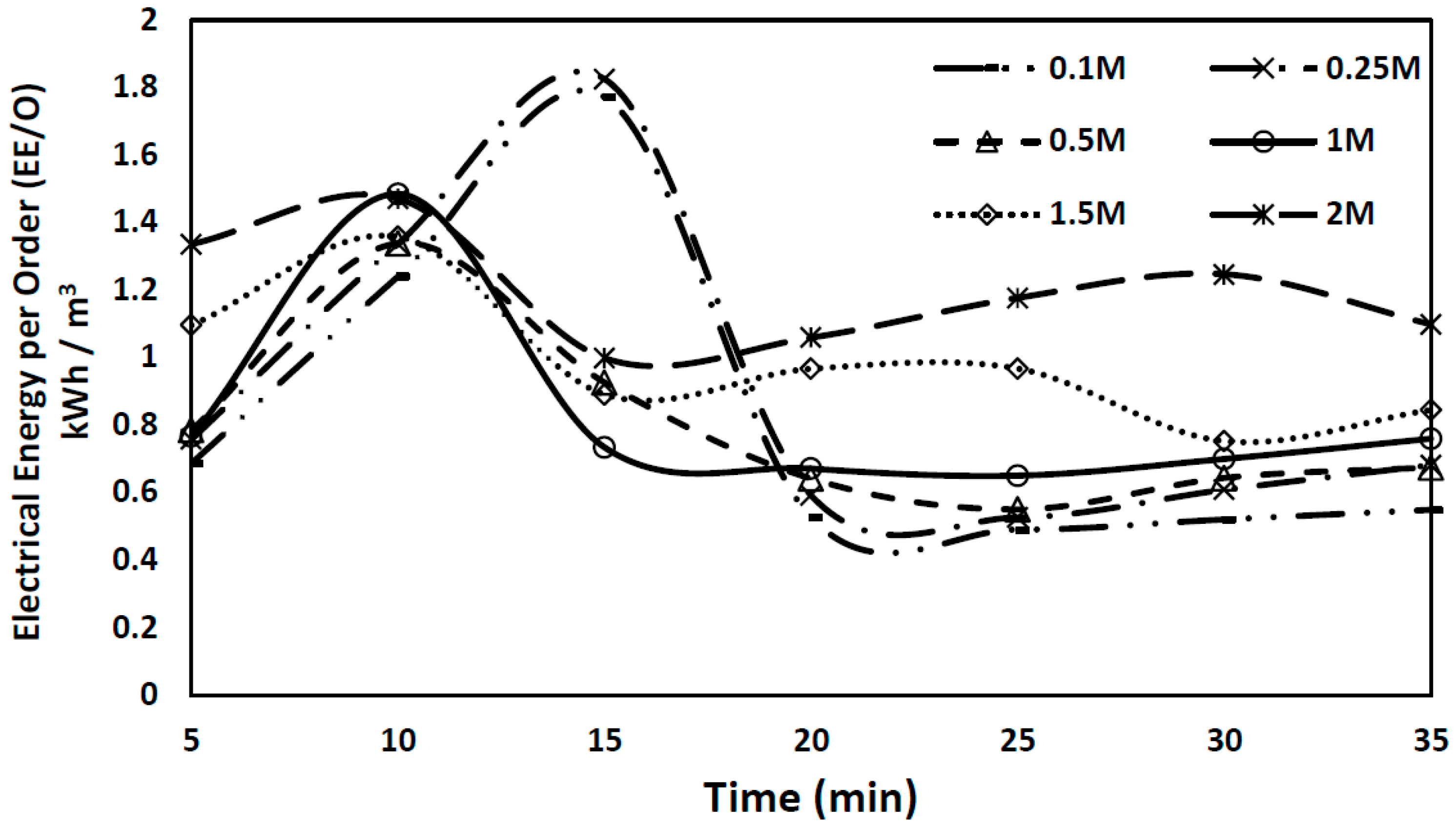
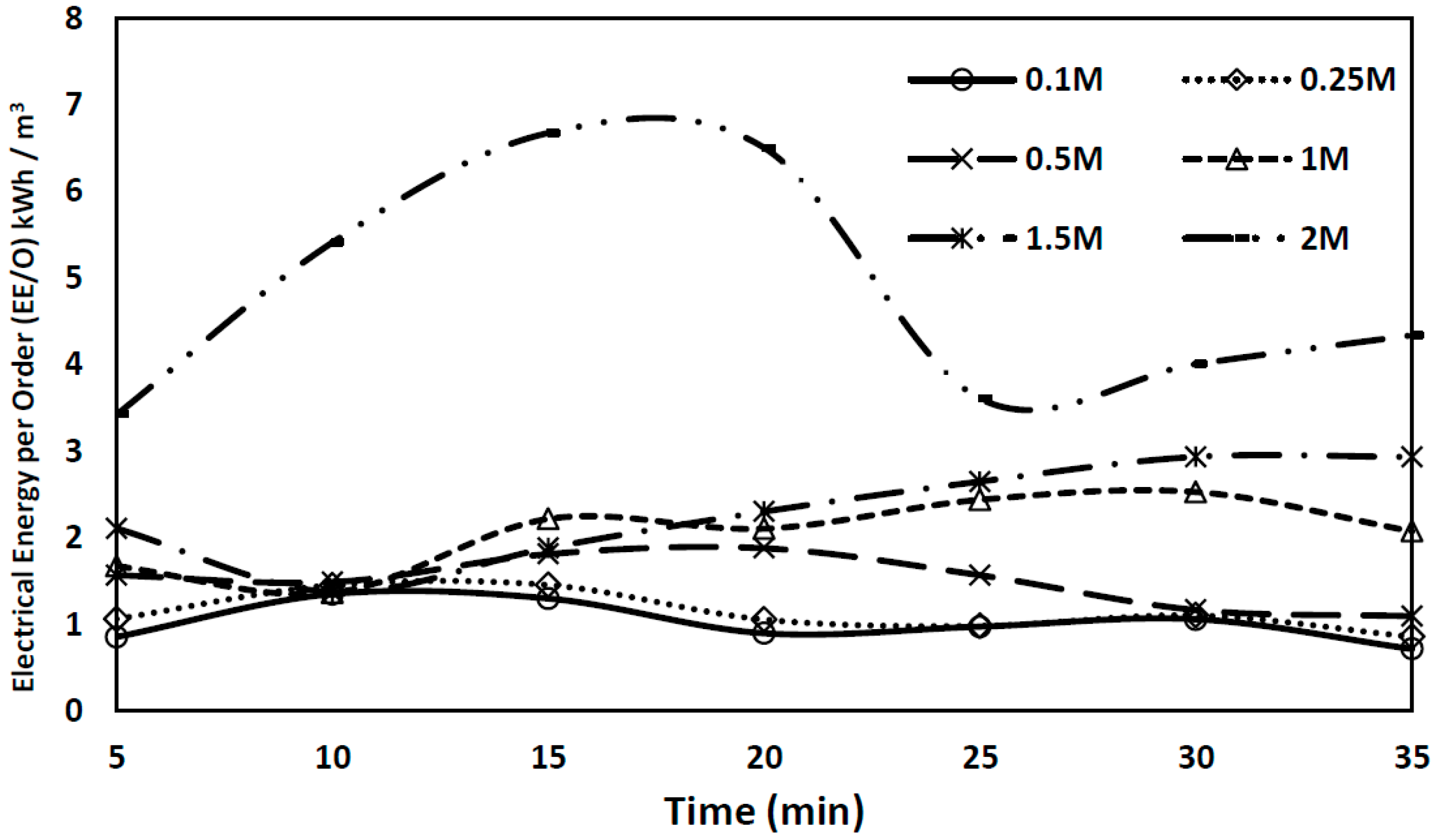
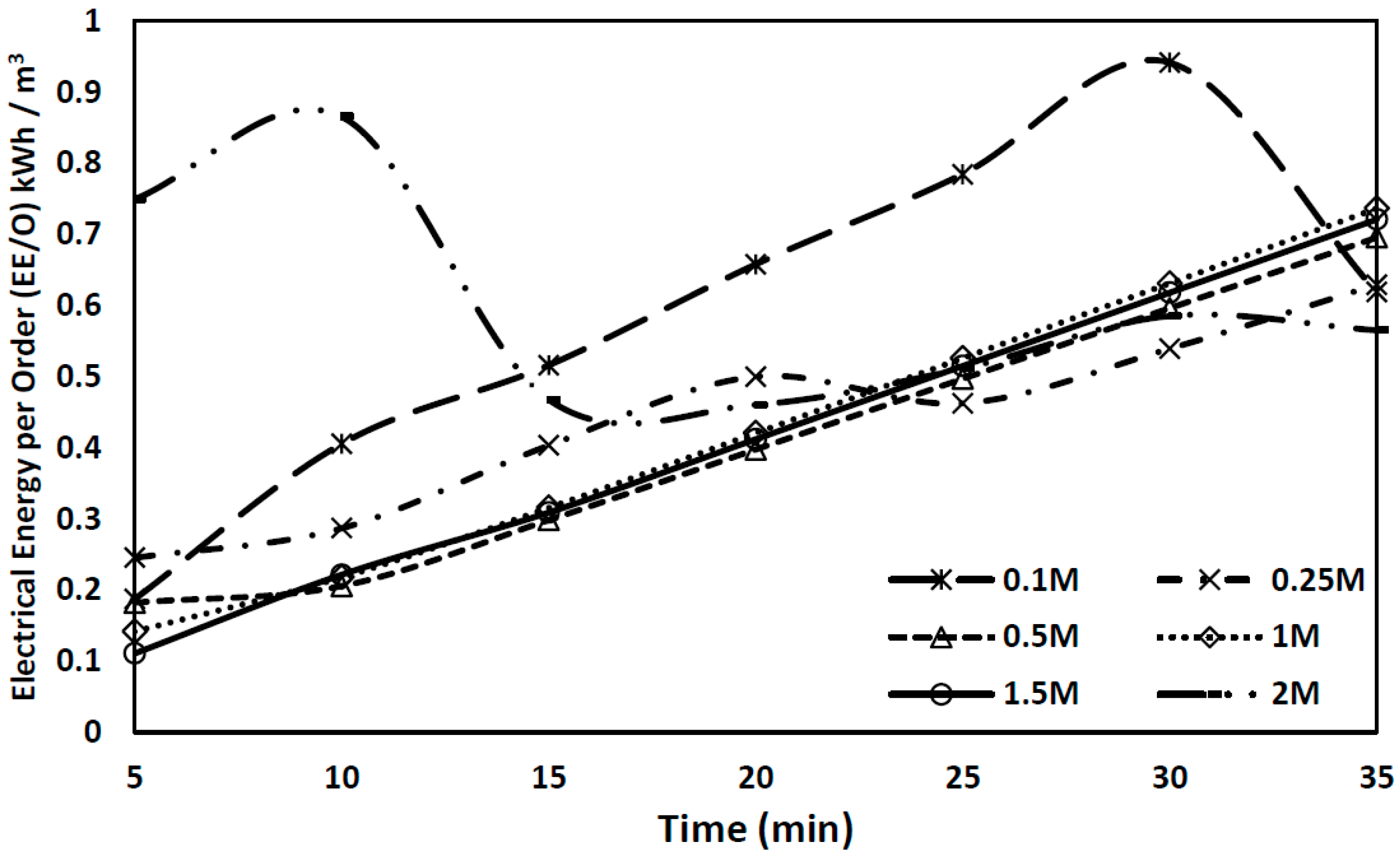

| Name | Acid Blue 25 Dye |
|---|---|
| Color: | Blue |
| Physical State and appearance | Solid powder |
| Molecular Weight | 416.382 g/mol |
| Exact/Monoisotopic Mass | 416.044287 g/mol |
| Surface Area | 138 Å2 |
| Atom Count | 29 |
| UV absorption (λmax) | 600 nm |
| Molecular formula | C20H13N2NaO5S |
| Molecular Structure |  |
© 2016 by the authors; licensee MDPI, Basel, Switzerland. This article is an open access article distributed under the terms and conditions of the Creative Commons Attribution (CC-BY) license (http://creativecommons.org/licenses/by/4.0/).
Share and Cite
El-Tayeb, A.; El-Shazly, A.H.; Elkady, M.F. Investigation the Influence of Different Salts on the Degradation of Organic Dyes Using Non-Thermal Plasma. Energies 2016, 9, 874. https://doi.org/10.3390/en9110874
El-Tayeb A, El-Shazly AH, Elkady MF. Investigation the Influence of Different Salts on the Degradation of Organic Dyes Using Non-Thermal Plasma. Energies. 2016; 9(11):874. https://doi.org/10.3390/en9110874
Chicago/Turabian StyleEl-Tayeb, Ahmed, Ahmed H. El-Shazly, and Marwa F. Elkady. 2016. "Investigation the Influence of Different Salts on the Degradation of Organic Dyes Using Non-Thermal Plasma" Energies 9, no. 11: 874. https://doi.org/10.3390/en9110874






